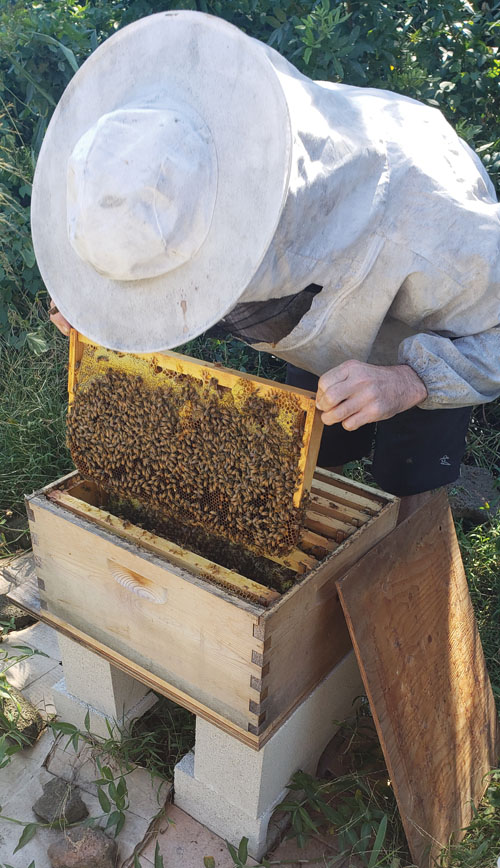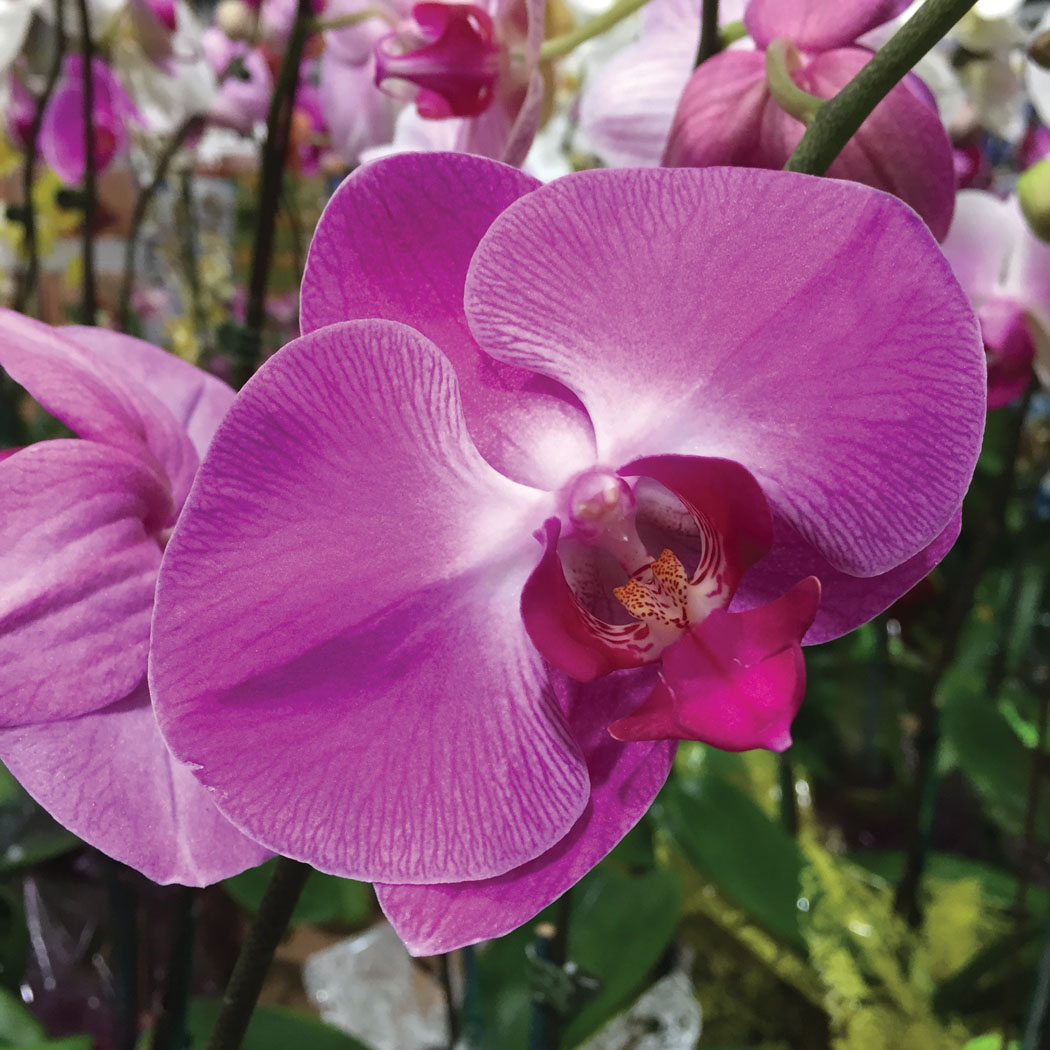
Letting the Bees Be: A Simple, Sustainable Approach to Bee Farming

By Sara Stover
Can bees smell fear, or is this a myth? The Bee Boys are the ones to ask, with their noses inches away from hundreds of wild honeybees on a daily basis. The Bee Boys are Kevin O’Connor and Ryan Williamson, and they are experts on the truth about honeybees and their impact on the economy and agriculture of Hawai‘i Island.
Walking from hive to hive, Kevin draws our attention to the queen bee. She looks the part, being larger than the other honeybees. Her function is to lay eggs, specifically about 1,500 every day. Most of the other bees are worker bees. All females, their job is to clean and feed the baby bees and the queen, pack pollen and nectar into cells, build honeycomb, and guard the hive. It is the worker bees that deserve credit for the harvestable products the Bee Boys obtain from the hive: bee bread, honey, wax, and propolis, which is a sticky bee-produced glue of sorts that offers many health benefits.

Outside the hive, the worker bees serve as field bees, collecting nectar and pollen from flowers, and gathering propolis. The field bees have a one-and-a-half mile flight radius, allowing them to pollinate all the nuts, seeds, fruits, trees, and more in an area that is considerably large for such a small creature.
Bigger than the worker bees, yet noticeably smaller than the queen, the remaining honeybees are drone bees. Their main responsibility is to mate with the virgin queen.
The Bee Boys, Kevin and Ryan, first heard the call of the wild honeybees while working at a commercial apiary on Hawai‘i Island. Philadelphia natives, they returned to that area briefly in 2008, and ran Beaupre Apiary in Pennsylvania. Fans of the Beaupre honey nicknamed Kevin and Ryan the “bee boys” and, like sticky propolis, the name stuck. Beaupre Apiary later evolved into Bee Boys LLC, and the two eventually returned to Hawai‘i Island to harvest and sell raw honey from their many hives. Today, the Bee Boys care for approximately 56 hives every day.
One needs only to spend a few minutes with the Bee Boys to realize that there is much more to bees than honey, and it all began with a kiawe (mesquite) tree.

Aloha to the Honeybee
Like Kevin and Ryan, the honeybee is not native to the Hawaiian Islands. The introduction of honeybees to the islands followed the arrival of the kiawe tree, originally from northwestern South America, which was introduced in 1828 by the head of the first Catholic mission on O‘ahu, Father Alexis Bachelot of France.
Father Bachelot brought a kiawe to Honolulu, where he planted the tree on the grounds of the Catholic mission. The offspring of that single tree reached all the way to the leeward plains of the neighbor islands by 1840. By the mid-1800s, the kiawe was being used as a high-protein feed source for cattle. To promote further kiawe growth, beekeepers brought the honeybee to the Hawaiian Islands in 1857 to increase kiawe pollination. Today, the Hawaiian honeybees are amongst the largest producers of honey in the world.
Being a beekeeper is a sweet job, and one that has a positive impact on the economy and agriculture of Hawai‘i Island; however, the job does come with its challenges. In 2007, the varroa mite arrived. Like blood-sucking ticks, the varroa mites can quickly destroy an entire colony. In 2010, the small hive beetle turned up on the island, further threatening honeybee colonies. Bee bread is especially attractive to hive beetles. Fortunately, bee bread has other uses that reduce the beetles’ effect. “The problem is the solution!” Ryan exclaims.
Bee bread, the primary food source for most bees and larvae, is composed of pollen mixed with small pieces of honey, beesʻ wax, and bees’ digestive enzymes. Containing essential amino acids and high levels of vitamins, enzymes, and flavonoids, bee bread is ideal for treating anemia, insomnia, lowering cholesterol, and reducing digestive tract disorders in humans.*
Bees generally have more bread than they need, so removing some of the bee bread is not detrimental to the hive. In fact, it decreases the threat of hive beetles, and makes room for the queen to lay more eggs.
“Bees are creatures of the sun,” says Ryan as he delicately holds up a bee from one of several hives, then releases it to fly off into the nearby trees. Winter and the decrease in sunlight that comes along with the season is not as great of a concern on Hawai‘i Island as it is on the mainland, yet it still presents a challenge to the apiary. To resolve this issue, the Bee Boys emphasize biodiversity to ensure that their bees have a variety of pollen sources with differing peak seasons, such as ‘ōhi‘a lehua, wilelaiki (Christmas berry), and macadamia nut.

Respecting the Bees
Of their beekeeping methods, Kevin says, “We are taking a respectful approach.” After years in the apiary business, both Kevin and Ryan have a deep understanding of the natural lifecycle of honeybees. They forego commercial treatments, like miticides, medications, and high-fructose corn syrup diets, which are fed to bees by many commercial farmers. This practice is thought to be connected to the decline of honeybee colonies, as a diet void of honey deprives the bees of a chemical that they depend on to break down toxins in pesticides used to destroy mites and beetles. Even with honey present in their diet, miticides and pesticides have the potential to negatively impact the honeybees’ health, since it has been proven that dosed bees garner less pollen than un-dosed bees.
The Bee Boys’ understanding of the honeybees’ natural habits is also behind their choice to keep the hives free of plastics. Comb is the hive’s frame and tissue, and bees create wax comb out of their abdomens naturally. This self-made wax is home to young bees in the colony, and the site of pollen and nectar storage, which the bees rely on for food. With this remarkable wax at their wing tips, plastic comb is unnecessary and possibly destructive. Honeybees forced to interact with plastics are exposed to hormone-interrupting off-gasses. This risk has prompted Kevin and Ryan to allow their hives to work with the wax comb the bees are already producing instead.
The Bee Boys’ hives are also free of artificially inseminated queens. Controlled by grafting from a small genetic pool, some apiaries place artificially inseminated queens in a nucleons colony of unrelated bees, and are often killed and replaced each year.
“We allow our bees to raise their own queens naturally,” Kevin asserts. “This lets the virgin queens follow true instinct and choose the strongest, healthiest drones to mate with, creating a true family unit.”
Humble Students of the Honeybee

Being part of bettering the local community and economy is a priority for the Bee Boys. Ryan points out, “In a time when farmers often struggle to make ends meet, we focus on what’s going right. We get to be part of driving the economy forward! Our vision is to continue perpetuating products made on the Big Island, with an emphasis on Ka‘ū branded products.”
That focus on community is a value that Kevin and Ryan have gleaned from their beehives. Within their community, the honeybees’ priority is the hive, not the individual. Any bee that is available will jump on a task if a job needs to be done. The bees also hold hands in a behavior known as festooning, forming a network of bees that hang between the honeycomb frames, which appears to act as scaffolding that they utilize to build honeycomb. Many suggest that wax can only be produced from the festooning position, which is important as the wax actually contains the honeybees’ DNA. The Bee Boys allow their hives to build comb naturally for this very reason, even if the comb is occasionally swirly and not always perfectly symmetrical.
Honeybees function as a harmonious community, and the Bee Boys are honored to be students of this buzzing society. These Na‘ālehu beekeepers are applying lessons they’ve learned from their bees to connecting with their own community, from Hawai‘i schools to libraries and other local businesses with sustainable practices. “Beekeeping is an incredible way to merge into our community,” Ryan shares.
With their honeybee expertise, the Bee Boys confirm that honeybees cannot smell fear. However, science suggests that chemicals known as pheromones are connected to their process of communicating about food sources and bees that need defending. A honeybee can also release pheromones to draw its swarm into new hives.
In the midst of the high-traffic honeycomb Kevin holds, a baby bee emerges from a hexagon as if from another world. There is an undeniable mystique to the honeybees, and the Bee Boys are much more than beekeepers. Kevin and Ryan are humble students of the honeybee. ❖
For more information: BeeBoys.org
Photos by Sara Stover
*According to www.phillyhoneyfest.com/2018/07/17/whatisbeebread.


